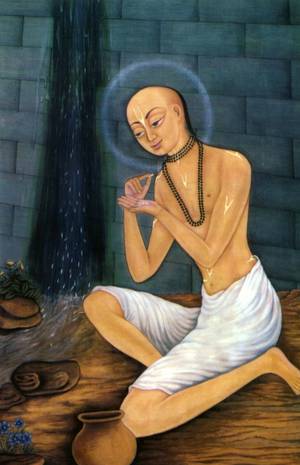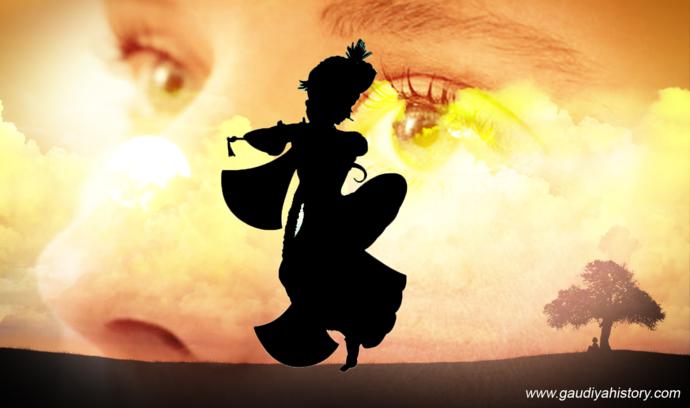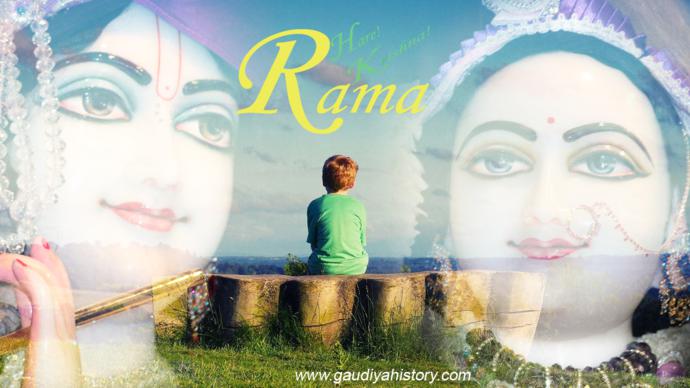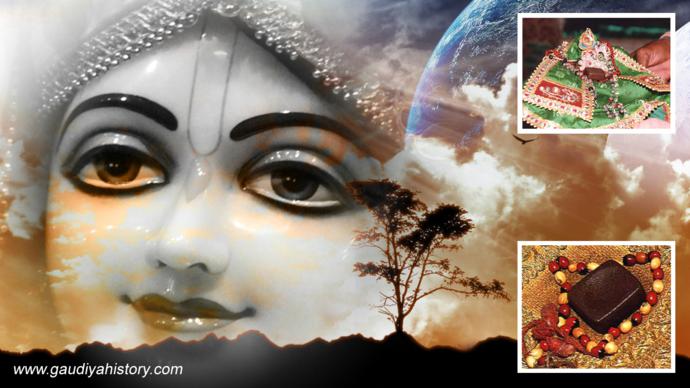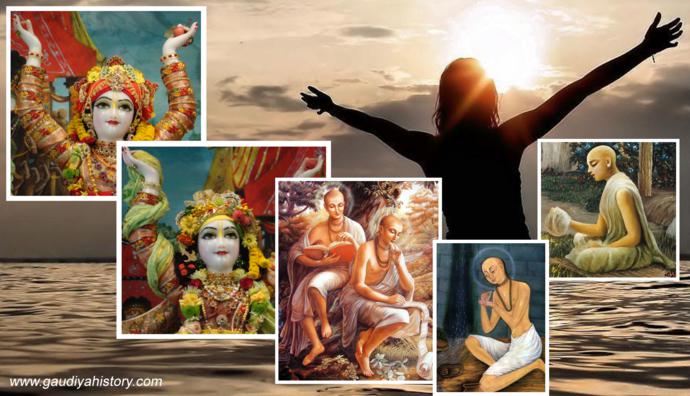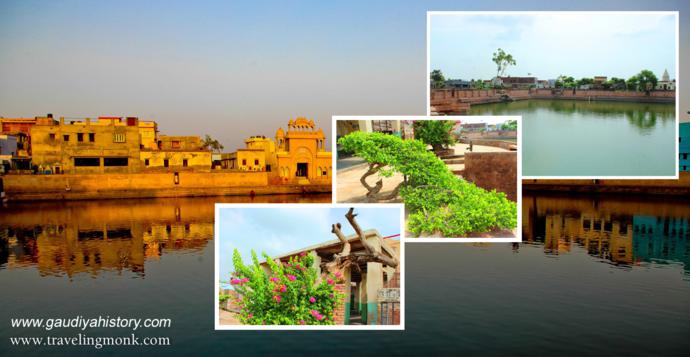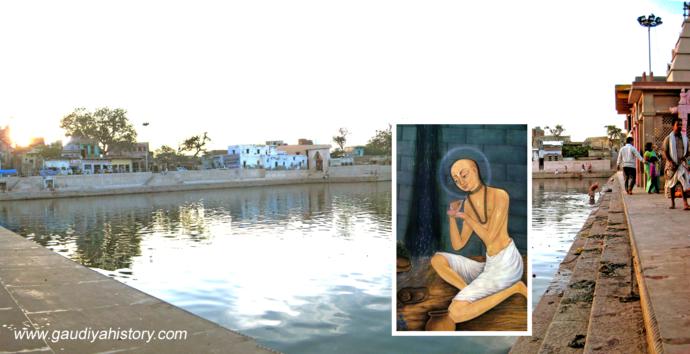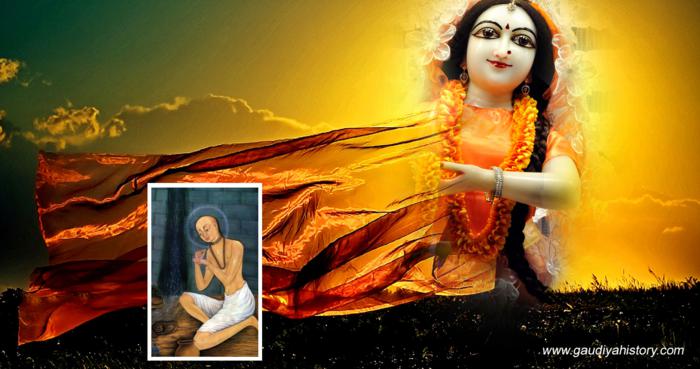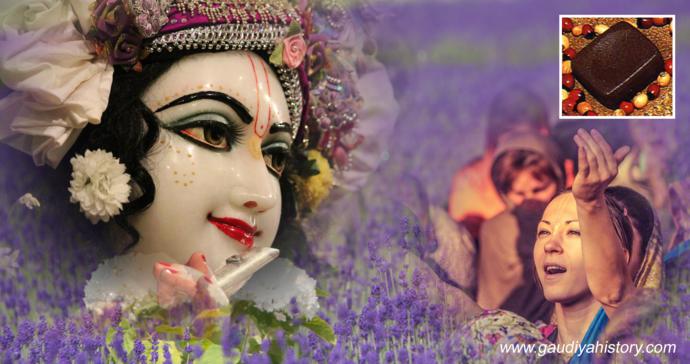dasa-raghunathasya purvakhya rasa-maïjari
amum kecit prabhashante shrimatim rati-maïjarim
bhanumaty-akhya kecit ahus tam nama-bhedatah
Raghnatha Das is ascribed three different names from his previous identity as a manjari in Krishna-lila: Rasa Manjari, Rati Manjari, and Bhanumati. (Gaura-ganoddesha-dipika 186)
Raghunath’s Childhood
Raghunath Das was born in around 1416 Shaka (1494 AD) in the town of Saptagram in Hooghly district. His actual birthplace was in the village of Krishnapura which is not far south of the current railway station name Adi Saptagram on the eastern bank of the ancient Saraswati River. Krishnapura is about a mile from Adi Saptagram station and approximately 1 miles from Trish Bigha station.
Shrila Raghunatha Das Goswami was the son of Govardhana Majumdar. His mother’s name is not known. Govardhana’s older brother Hiranya had no male offspring. The two brothers belonged to the kayastha caste and were the primary landholders in Saptagram. In those days, the borders of Saptagram stretched from the Yashohara Bhairava creek almost up to the Rupa Narayan River. Raghunath lived in Saptagram Krishnapura, his uncle Kali Das, who was also Chaitanya Mahaprabhu’s Devotee, lived in Shankhanagara. Raghunath’s family priest, Balaram Acharya and his guru, Yadunandana Acharya, lived in the town of Chandpura. Yadunandana was a intimate disciple of Advaita Acharya and a dedicated Devotee of Lord Chaitanya Mahaprabhu who had also received the special blessings of Vasudeva Datta Thakur.

Raghunath Das was just a little boy engaged in studies he had the darshan of Hari Das Thakur. Hari Das was merciful to him and this mercy was the reason that he later was able to attain the company of Lord Chaitanya. (Chaitanya Charitamrita 3.3.168-9) (In the image: Shrila Haridas Thakur, a child).
After delivering the prostitute sent to tempt him by Ramachandra Khan, Hari Das Thakur left Benapole and came to Chandpura where he stayed with Balaram Acharya. Shrila Raghunath Das Goswami was just a young boy at this time, but he had the opportunity to see Hari Das Thakur and receive his blessings. Krishnadas Kaviraj Goswami says that these blessings were the cause of Raghunath’s later being able to attain the association of Mahaprabhu in the last years of his life.
Raghunath Das was just a little boy engaged in studies he had the darshan of Hari Das Thakur. Hari Das was merciful to him and this mercy was the reason that he later was able to attain the company of Lord Chaitanya. (Chaitanya Charitamrita 3.3.168-9)
Raghunath’s Desire to Join the Lord
Hiranya and Govardhana Majumdar had an annual income of 800,000 rupees. At that time, a rupee could buy about 650 lbs of rice, which means several hundred times the value of a rupee today. Even though Raghunath was the only heir to this great fortune, he was indifferent to riches from his childhood. He had his first opportunity to see Mahaprabhu when the Lord came to Shantipur after taking sannyas. As soon as he saw the Lord, Raghunath fell to His feet in a transport of divine love. Raghunath’s father, Govardhana Majumdar, always served Advaita Acharya with faith and devotion, and thus Advaita Prabhu was predisposed to show kindness to the young Raghunath. He thus made sure that Raghunath received the Lord’s remnants for as long as he remained in Shantipur.
When the Lord departed for Puri, Raghunath returned to his home in Saptagram, but he had been transformed and was constantly feeling intense separation from the Lord. Seeing him in this condition, his father surrounded Raghunath by a guard of eleven men, including two Brahmins, four servants and five guards. Even so, Raghunath tried on several occasions to run away in order to join the Lord, but each time was caught and brought back before realizing his objectives. Raghunath became progressively depressed as a result of this situation.
In 1513, when the Lord made His attempt to visit Vrindavan, but only managed to get as far as Kanair Natashala, he returned to Shantipur and again stayed there for a short period of time. Raghunath wanted to see the Lord and this time begged his father to give him permission to go to Advaita’s house. Govardhana was worried about the state of his son’s mind and finally decided to let him go on condition that he return quickly. He also sent a large entourage of guards to accompany him.
When Raghunath saw the Lord, it was as though he regained a new lease on life. He told the Lord of the intolerable situation he was living and prayed to him to tell him how he could break free from the bondage of his material existence. The all-knowing Lord could understand the depth of Raghunath’s feeling and yet He tried to pacify him with the following instruction:
“Calm yourself and return home. Don’t be foolish. It takes time to cross the ocean of material suffering. Don’t make a show of “monkey renunciation” (markata-vairagya) simply for other people’s benefit. Enjoy the worldly life in a moderate way without attachment. Be fixed on Krishna internally while externally dealing with the world in the appropriate fashion. It will not be long before Krishna delivers you.” (Chaitanya Charitamrita 2.16.237-9)
Shrila Bhaktisiddhanta Saraswati Goswami Thakur has made the following comments on the word markata-vairagya: “To a superficial eye, monkeys are engaged in renunciation because they live naked in the forest without any fixed home. In fact, they are only interested in their own sensual enjoyment and have never given it up. Such show-bottle renunciation is called markata- vairagya, ‘monkey-renunciation’. Real renunciation comes as a side-effect of pure devotion, and other types of renunciation which arise out of frustration with material pleasures or desires cannot last throughout one’s life. Because of its temporary character, such renunciation is therefore called phalgu, or false. Such temporary renunciation, or monkey renunciation, is also known as shmashana-vairagya, ‘the renunciation of the cremation ground.’
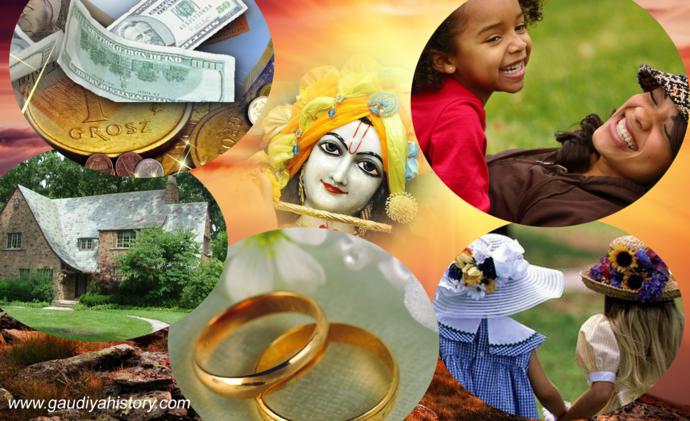
Shri hari-sevaya jâha anukula, vishaya boliya tyage haya bhula-- “It is a mistake to renounce something which is favorable to the service of Lord Krishna, thinking it to be an ordinary material sense object.” (In the wallpaper: Shri Gopinath, ISKCON Chowpatty, Mumbai).
“One may accept things which are absolutely necessary in order to serve Krishna without becoming absorbed by them or attached to them. If one lives in this way, he will not be under the influence of the karmic reactions resulting from the involvement with sense objects. In the Bhakti-rasamrita-sindhu (1.2.108), it is said:
yavata syat sva-nirvahah
svikuryat tavad arthavit
adhikye nyunatayam ca
cyavate paramarthatah
One who knows his purpose should accept only as much as he needs to maintain his existence. If he accepts more or less than that, he will fall from the supreme objective.
Shri Jiva Goswami glosses the word sva-nirvahah in his Durgama-sangamani commentary with the words sva-sva-bhakti-nirvahah, i.e., a Devotee should accept only those material things that will help him render service to the Lord, according to his own individual needs. In the Bhakti-rasamrita-sindhu (1.2.256), markata-vairagya, or phalgu-vairagya, has been more clearly explained as follows:
prapaïcikataya buddhya
hari-sambandhi-vastunah
mumukshubhih parityago
vairagyam phalgu kathyate
Phalgu-vairagya is defined as the rejection by one desiring liberation of something which is related to the Lord in the understanding that it is something material.
Shri hari-sevaya jâha anukula, vishaya boliya tyage haya bhula– “It is a mistake to renounce something which is favorable to the service of Lord Krishna, thinking it to be an ordinary material sense object.”
anasaktasya vishayan
yatharham upayuïjatah
nirbandhah krishna-sambandhe
yuktam vairagyam ucyate
Yukta-vairagya is defined as the attitude of one who is detached from the objects of the sense, but uses them only in as much as they have utility in the service of Lord Krishna.
[From Vaishnava ke?] asakti-rahita sambandha sahita vishaya-samuha sakali madhava — ”All sense objects which are used without personal attachment and in relation to Krishna are identical to Krishna.” Taking Mahaprabhu’s instruction to heart, Raghunath returned home and gave up his feverish desire to renounce material life and instead engaged in his various duties with a sense of detachment. When his parents saw Raghunath abandon all the external signs of renunciation, they were delighted and they began to think that there was no necessity for such a tight guard around their son.
Hiranya Majumdar’s Tax Problems
In those days, there was an officer of the Shah with the title chaudhuri or nayeb who acted as an intermediary between the Shah and the zamindars. He collected taxes from the landowners and received a commission of 25% on them. Hiranya Majumdar, however, paid his taxes directly to the Shah, with whom he had a special agreement and thus cut out the middle man. Thus, on an income of 2,000,000 rupees, Hiranya was paying only 1,200,000 rather than 1,500,000, the difference which would normally have been paid to the chaudhuri. Since he was losing a large amount of commission, the Turkish Muslim chaudhuri became an enemy of the Majumdars. Ever since returning from his meeting with Mahaprabhu, Raghunath was practicing yukta-vairagya in accordance with the Lord’s instructions. However, when he heard that Mahaprabhu had returned from Vrindavan, he started making preparations to join Him in Puri. At that time, the chaudhuri had started making complaints to the Shah about Hiranya and Govardhana out of anger at being cheated of his percentage of the tax revenue. Fearful of arrest, the two brothers had gone into hiding.
When the minister came to investigate the chaudhuri’s complaints, he arrested Raghunath, since his father and uncle were not present. The chaudhuri came daily to rebuke and threaten Raghunath, asking him to reveal their whereabouts. Finally he decided to have Raghunath beaten, but when he saw his calm, lotus-like face, he was unable to continue. In fact, though he verbally chastized him, the chaudhuri was afraid to cause him any real harm because Raghunath belonged to an influential family of the kayastha class. He knew that the kayasthas are intelligent and could plot against him, causing him worse problems.
Raghunath himself was looking for a way to extricate himself from the situation, and spoke to the chaudhuri in a sweet voice: “My father and uncle are like your brothers. The behavior of brothers is difficult to understand–sometimes they fight amongst themselves, sometimes they are loving to each other. Today you are arguing, but tomorrow, I am sure that you will be reconciled with each other. I am your son as much as I am my father’s and therefore you are my protector. It is not right for one such as yourself to punish his dependent. I need say no more, for you know the scriptures and are practically a living saint, a pir.”
The chaudhuri was affected by Raghunath’s sweet words and began to cry as he was overcome by affection for him. He said, “From now on, I consider you to be my son. I will find an excuse to have you freed today. Have your uncle meet with me and make arrangements so that I can get my share of the revenues.”
Thus Raghunath was able to mollify the chaudhuri by his sweet and diplomatic behavior and bring the dispute between him and his uncle to an end. In the meantime, Raghunath’s father was making arrangements for his son’s marriage to an extremely beautiful girl in order to insure his commitment to the family.
The Danda-mahotsava
A year later, Raghunath once again became anxious to see Mahaprabhu and repeatedly ran away from home in an effort to go to Puri. Each time, he was caught by his father and returned home. Raghunath’s mother thought that her son was going mad and told her husband to place him under guard again. Govardhana responded in defeated tones,
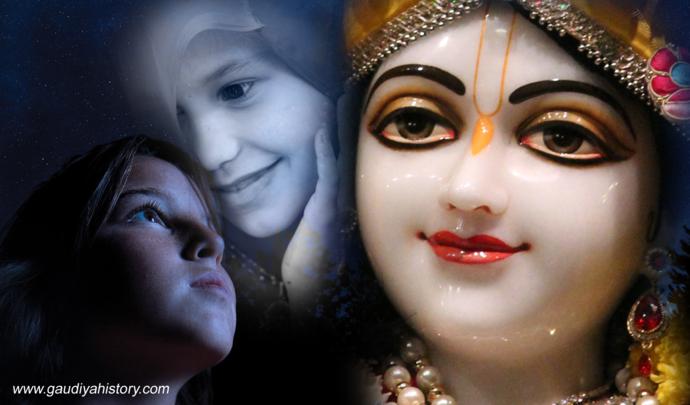
“He has as much wealth as Indra, the king of the gods, and his wife is as beautiful as the heavenly courtesans. If these things have not been able to capture his spirit, then how will mere ropes be able to do so? The father who gives life to a child cannot interfere with the effects of his previous lives’ actions. Shri Chaitanya Chandra has given His blessings to this boy. Who can keep prisoner one who was been made mad by Lord Chaitanya Mahaprabhu?” (Chaitanya Charitamrita 3.6.39-41) (In the wallpaper: Shri Gauranga Mahaprabhu, ISKCON Chennai, a boy, a girl).
“He has as much wealth as Indra, the king of the gods, and his wife is as beautiful as the heavenly courtesans. If these things have not been able to capture his spirit, then how will mere ropes be able to do so? The father who gives life to a child cannot interfere with the effects of his previous lives’ actions. Shri Chaitanya Chandra has given His blessings to this boy. Who can keep prisoner one who was been made mad by Lord Chaitanya Mahaprabhu?” (Chaitanya Charitamrita 3.6.39-41)
While Raghunath Das was devising a plan for how he would be delivered from his entanglements, he heard that Nityananda Prabhu had made an auspicious appearance in the town of Panihati. Thinking that Nityananda was the deliverer of the most fallen and that by his mercy he would surely be able to find his freedom, he went across the Ganges to Panihati where he found the Lord sitting under a tree on a wooden seat, surrounded by his associates. As soon as Raghunath saw him from a distance, he fell down like a rod. The merciful Lord Nityananda immediately had him brought close to him and, understanding the deep-rooted desires of Raghunath’s heart, arranged for him to perform a service to the Vaishnavas so that he could realize them.
“Like a thief, you don’t come near me, but simply try to run away. Now that I have caught you, I shall punish you. I want you to feed all my followers chipped rice and yogurt.” When he heard Nityananda’s command, Raghunath’s mind was filled with joy. (Chaitanya Charitamrita 3.6.50-1)
The festival which Nityananda ordered Raghunath to put on is still celebrated as the Panihati Chiriadadhi Mahotsava. Nityananda Prabhu and a manifestation of Shri Chaitanya Mahaprabhu Himself celebrated the festival, eating on the banks of the Ganges just as though they were cowherd boys on the banks of the Yamuna River. Shri Chaitanya Mahaprabhu, Nityananda Prabhu, their associates, numerous Brahmins and countless men and women from the area enjoyed a feast of milk and chipped rice and yogurt and chipped rice. The opportunity to serve the Lord and His Devotees in this way was something that could not come about except for some great fortune.

“Like a thief, you don’t come near me, but simply try to run away. Now that I have caught you, I shall punish you. I want you to feed all my followers chipped rice and yogurt.” When he heard Nityananda’s command, Raghunath’s mind was filled with joy. (Chaitanya Charitamrita 3.6.50-1) (In the wallpaper: Yamuna, in the image left below Raghunatha Das Goswami, Lord Nityananda and other Devotees, image right top Gaura Nitay and Devotees, chipped rice cooked in milk).
On the following day, Raghunath Das Goswami emotionally asked Nityananda through Raghava Pandit how he could possibly gain freedom from his material entanglements and find the association of Mahaprabhu. Like an ocean of mercy, Nityananda Prabhu placed his feet on Raghunath’s head and said,
“You arranged this feast on the banks of the river and Mahaprabhu was merciful to you and came here Himself to enjoy it. He blessed you by accepting the offering of chipped rice and yogurt. Then, after watching the Devotees’ dancing, He took Prasad in the evening. Lord Gauranga came here just to deliver you and now He has removed any impediments which remained. He will turn you over to Svarupa Damodar and making you His confidential servant, He will keep you by His side. Go home now and forget your worries. You will soon be able to go to the Lord without any difficulties.” (Chaitanya Charitamrita 3.6.139-143)
After discussing with Raghava Pandit, Raghunath gave a large sum of money as dakshina to be paid to Nityananda and his associates. He himself felt as though his life had been fulfilled after receiving Nityananda Prabhu’s blessings. Upon returning to his house, he never again entered the inner quarters, but remained outside where he slept in the Durga Mandapa. Nevertheless, there was always a guard posted near him to prevent him running away.
Raghunath Escapes
Though Raghunath knew that the Devotees from Bengal were preparing their annual trip to Puri, he was afraid of joining them because he knew that he would easily be caught. One day, about an hour before dawn, Yadunandana Acharya came by the house while Raghunath was sleeping on the Durga-mandapa. He told Raghunath that a disciple who performed the puja had abandoned his service and needed to be persuaded to take it up again as there was no replacement.
Raghunath accompanied his guru while all the guards were still sleeping. After walking a way with Yadunandana Acharya, however, Raghunath told him to return to his home, saying that he would go alone to the disciple’s house and convince him to come and perform his duties. He told him not to worry and bid him goodbye. With no guards or servants around him, Raghunath realized that he had a golden opportunity to make his escape.
Meditating on Mahaprabhu’s lotus feet, he started to walk toward the east. He avoided the main roads for fear of being caught and even the smaller roads through the villages. Despite the difficult route through the jungle, he walked thirty miles on the very first day, finally taking rest in a milkman’s cowshed that evening. The milkman saw that he had not eaten for the entire day and gave him some milk.
When Govardhana heard that his son had run away, he immediately sent a group of ten servants with a letter for Shivananda Sena who was already on his way to Puri with the Devotees, telling him to send Raghunath back. They caught up with the group of pilgrims at a place called Jhankara, but were disappointed to find that Raghunath was not with them. Meanwhile, Raghunath was walking at great speed towards Puri, completely oblivious to his own fatigue and hunger.
Raghunath arrived in Puri after only twelve days, having stopped to eat only three times along the way and resting only infrequently. He came upon Mahaprabhu, who was sitting with Svarupa Damodar, and paid his obeisances to the Lord from a certain distance. Mukunda Datta informed the Lord that Raghunath had arrived and was paying his obeisances. The Lord told him to approach and Raghunath fell at His feet. The Lord embraced him, His heart melting with compassion for the exhausted young man. He said, “Nothing is more powerful than Krishna’s mercy. It has dragged you out of the deep latrine hole of sense gratification.” (Chaitanya Charitamrita 3.6.193) Raghunath answered the Lord mentally, thinking, “I know nothing about Krishna. I believe that it was You who pulled me out of that hole.” Mahaprabhu’s maternal grandfather, Nilambara Chakravarti knew Raghunath’s father and uncle and used to call them bhaya because they were younger than he. They too called him dada (“older brother”) because he was their elder and a Brahmin. Knowing that this relationship existed between them, Mahaprabhu joked with Raghunath, saying:
“Your father and uncle are like worms in the latrine pit of sense gratification. They think that the suffering which comes from sense gratification is happiness. Even though they believe in brahminical culture and contribute to it, they are not pure Vaishnavas, only imitation Vaishnavas. The nature of the sense objects is that they make one blind; they make one engage in activities which result in material bondage. It is not possible to properly describe Krishna’s mercy which has delivered you from such bondage.” (Chaitanya Charitamrita 3.6.197-200)
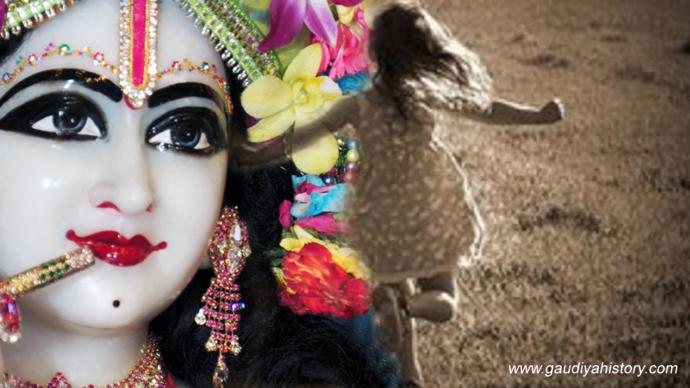
“Nothing is more powerful than Krishna’s mercy. It has dragged you out of the deep latrine hole of sense gratification.” (Chaitanya Charitamrita 3.6.193) Raghunath answered the Lord mentally, thinking, “I know nothing about Krishna. I believe that it was You who pulled me out of that hole.” (In the wallpaper: Shri Govinda, ISKCON Tirupati, a girl).
Shrila Bhaktisiddhanta Saraswati Goswami Thakur has written the following about Krishna’s mercy and the suffering caused by the poison of sense gratification: “Krishna’s mercy is more powerful than the results of one’s previous activities. It was this powerful compassion of the Lord which pulled Raghunath out of the latrine hole of sensual existence. A living entity who is attached to sense gratification does not have the strength to give it up. For the living being who has become a pure Devotee of Krishna, however, sense enjoyments are like a ditch of stool. Mahaprabhu knew that Raghunath was completely free from any attachment to sense gratification. Nevertheless, He said this to him as a teaching to the conditioned souls.” (Anubhashya 6.9.193)
“Sense objects (vishaya) bring great distress to their so-called enjoyer (vishayi). Even so, those whose brains are completely immersed in the objects of sense gratification and are entangled in the whirlpool of material existence consider these sources of distress to be happiness. The objects of material sense gratification should be discarded in the same way that one abandons an outhouse, and one whose mind is possessed by the desire for these objects of gratification is like a maggot who feeds off the stools in the latrine. This is how the transcendentalist sees the materialistic person who is trying to extract pleasure from inert matter. He has nothing but disdain for materialistic pleasures which he sees being exactly like the pleasure a maggot extracts from the taste of rotting excrement.” (Anubhashya 6.9.197)
Raghunath’s Renunciation
Mahaprabhu noticed that Raghunath was dirty and weak after his journey and so, after accepting him as His own son and servant, entrusted him to Svarupa Damodar, telling him take responsibility for him and to see to his well-being. He was thenceforth to be known as Svarupa’s Raghunath to distinguish him from Raghunath Vaidya and Raghunath Bhatta, who were also living in Mahaprabhu’s association in Puri at that time. The Lord also told Govinda to take care of Raghunath with great affection. He then told him to go and take his bath in the ocean and go to see Lord Jagannath, after which He was to join him for lunch. When Govinda gave Raghunath the remnants of the Lord’s plate to eat, Raghunath was overjoyed.
Things went on like this for five days, Raghunath taking the Lord’s remnants each day, but on the sixth day, he stopped taking the Lord’s Maha Prasada. From that day on, he went to the Jagannath Temple and took darshan of the Lord’s flower offering, after which he would stand at the Lion’s Gate and beg Maha Prasad. At night, after they had finished their duties, Jagannath’s servants would pass by on their way home and would customarily give Prasad to any hungry Vaishnavas who waited there. In this way, renounced Vaishnavas could keep body and soul together. This type of renounced attitude was particularly noticeable amongst Mahaprabhu’s Devotees.
When the Lord asked after Raghunath and learned that he was no longer taking Prasad in the same way as before, but begging by the Simha-dvara, He was satisfied to see that he was taking the renounced way of life so seriously. He said,
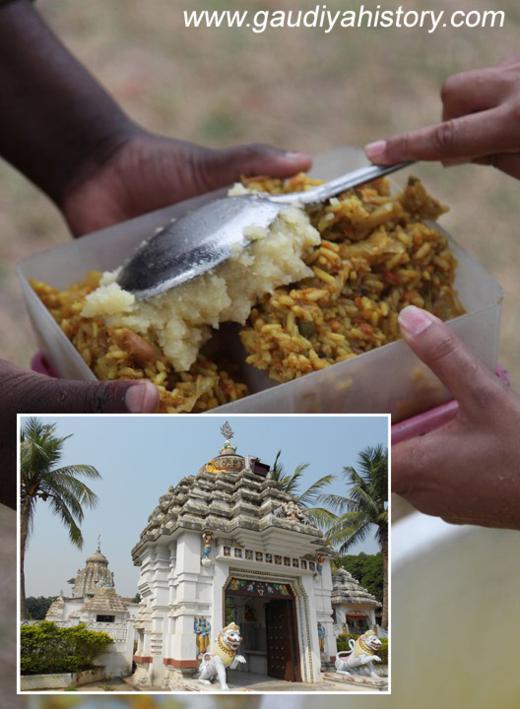
“That’s very good. He is taking the life of a renunciate seriously. A renunciate should always be engaged in repeating the names of the Lord and should keep his body and soul together through begging. Anyone who takes the renounced order and then becomes dependent on others cannot achieve his ends and Krishna will ignore him. One who becomes a renunciate and then lusts for tasty foods will never attain his spiritual goal, and will simply become the slave of his tastebuds. A vairagi’s duty is to always chant the names of Lord Krishna and fill his belly with spinach leaves, fruits and roots. One who runs here and there looking for good things tyatharham upayuo eat becomes attached to his sex organs and his belly and will never attain Krishna.” (Chaitanya Charitamrita 3.6.222-7)
Shrila Bhaktisiddhanta Saraswati Goswami Thakur has underscored Krishnadas Kaviraj Goswami’s statement that the vairagi’s only duty is to chant the names of the Lord. He has written the following: “Examining them impartially, both materialistic non-devotees and pure Vaishnavas can see that Mahaprabhu’s associates are not attached to the gratification of their material senses. They are indifferent to anything which cannot be used in the service of Krishna. The reasons for such renunciation are incomprehensible to the ordinary materialistic person, for their service is without any external motive and it cannot be interrupted by any mundane impediment. When Lord Gaurasundara sees a Devotee engaged in this kind of devotional service, completely indifferent to sense objects which are outside the scope of his service needs, He is greatly pleased with his clever attitude.
“The various rituals which are described in the Hari-bhakti-vilasa are meant for the wealthy householder and not for the vairagi who has renounced everything to take exclusive shelter of the Holy Name. One who chants the Holy Names in the morning, in the middle of the night, in the midday and at sunset, in other words throughout the day and night is certain to cross over the ocean of material existence. Those pure Devotees who are fixed exclusively on the devotional service of the Lord and chant His names and remember Him with love have no duty to perform other than kirtan and smarana.” (Anubhashya 3.6.223, translation of Hbv 20.366, 379, 382).
Shrila Raghunath Das Goswami would never speak to the Lord directly, but asked Govinda or Svarupa Damodar to submit any question or request to the Lord on his behalf. One day he asked the Lord through Svarupa Damodar to instruct him personally on his duties. When the Lord heard this, He told Raghunath that Svarupa Damodar knew far more than He did and that he should take instruction from him about the goal of life and how to attain it. When Raghunath’s eagerness to hear from him directly did not abate, the Lord said, “If he has faith in My words, then let him follow these instructions:
“Do not listen to gossip nor engage in gossip yourself. You should not eat very palatable food, nor should you dress very nicely. Always chant the Holy Name of Lord Krishna without any expectation of honor, offering all respect to others. Mentally render service to Radha and Krishna in Vrindavan.” (Chaitanya Charitamrita 3.6.236-7)
The Bengali Devotees arrived in Puri for Rathayatra and met Raghunath, who was particularly fortunate to receive Advaita Prabhu’s blessings. Shivananda Sena told him that his father had been looking for him. After staying four months in Puri, the Devotees returned to Bengal and Shivananda gave news of Raghunath to Govardhana Majumdar, telling him of his determined ascetic spiritual practices. Raghunath’s parents were distressed to hear of his lifestyle and sent a Brahmin, two servants and four hundred rupees to Shivananda for Raghunath. The following year, Shivananda took these servants and the money to Puri with him and informed Raghunath that his father had sent them. Raghunath would not accept them, but thinking of his father’s benefit, he took some of the money and used it to pay for Mahaprabhu’s meals twice a month. After doing this for two years, Raghunath abandoned this practice also. In response to Mahaprabhu’s question about why Raghunath had stopped inviting Him, Svarupa Damodar said that Raghunath had decided that since his father was a materialistic man, Mahaprabhu was not really pleased to eat the food purchased with his money. By accepting such money his own mind was becoming contaminated and his only gain was some fame and status. Furthermore, he thought that Mahaprabhu was only accepting his invitations out of kindness because Raghunath was so foolish that he would be unhappy if he refused, but that in fact he was secretly not very pleased by it. Mahaprabhu was greatly satisfied to hear this conclusion and said,
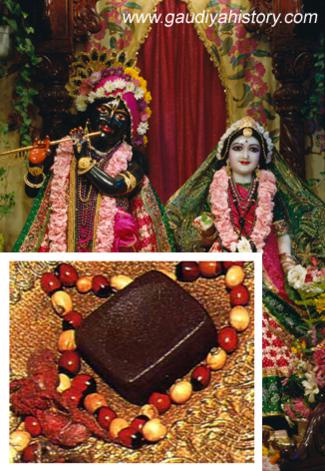
...Mahaprabhu cherished the two objects, taking the necklace of gunja beads to be identical to Radharani and the stone from Govardhana to be identical to Krishna...After worshiping the necklace and the stone for three years, He decided one day to give them to Raghunath as a sign of His satisfaction with his devotion...Raghunath felt honored and delighted by the Lord’s gift, and taking them to be the direct representations of Shri-Shri-Gandharvika-Giridhari, he worshiped them with water and tulasi leaves...(In the wallpaper: Govardham Shila of Raghunatha Dasa Goswami, Shri Shri Gandharvika Giridhari, ISKCON Sweden, New Radhakund).
“When one eats food offered by a materialistic person, one’s mind becomes contaminated. If the mind is contaminated, one is unable to remember Krishna. The food of a materialistic person is infected by the mode of passion and both the person who offers it and the one who accepts it are mentally contaminated. I accepted Raghunath’s invitation for many days because of his enthusiasm. I am glad that he has realized all this and given up this practice on his own initiative.” (Chaitanya Charitamrita 3.6.278-80)
Shrila Bhaktisiddhanta Saraswati Goswami Thakur has commented on the above events as follows: “People who are egotistical and possessive are generally materialistic persons who try to enjoy the world for their own sense gratification. Such persons see their money as a tool for achieving such sense gratification. If they attempt to serve the Lord, the guru or the Vaishnavas, who are beyond the material energy, their only gain will be an increase in material prestige and not the true benefits of such service. One who seeks true auspiciousness should therefore try to serve the Supreme Personality of Godhead by full surrender to His lotus feet and then engaging whatever money one has honestly earned in the spiritual service of Krishna, the spiritual master and the Vaishnavas, using his body, mind, words and heart.” (Anubhashya 3.6.275)
“Certain materialistic persons who are intoxicated by high birth, riches, learning or physical beauty, may make a show of Deity worship, offer the Prasad from that worship to Vaishnavas. Due to their ignorance, they are not aware that because they lack devotion, the Lord does not accept their offerings. Because of the taint of the sense enjoyer’s false pride which contaminates such offerings, it is often seen that the pure Vaishnava is indifferent to such apparent service to the Deity. In other words, a pure Vaishnava who has renounced the life of sense enjoyment does not accept such service. Rich materialistic sense gratifiers are so foolish because of their sense of identification with the body and mind that they become angry with the Vaishnavas and offended by their behavior. (Anubhashya 3.6.276)
“Non-devotees and Prakrita-sahajiyas are considered to be materialistic, or vishayis. Because they offer food without devotion, an aspiring Devotee will be contaminated by their association through eating their food. The result of such flaws in association (sanga-dosha), one will develop the same mentality as they. If one engages in even minimal association with materialists or Sahajiyas, who are materialists in the guise of Vaishnavas, through any of the six kinds of association (exchanging gifts, food or confidences), with even a drop of hidden affection, the result will be that the transcendental devotional service of Lord Krishna is transformed into sense gratification, and this will cause the aspiring Devotee’s falldown. The conclusion is that one whose mind is fixed on the pleasures of the bodily senses and contaminated by the sense objects is too impure to be able to serve Krishna through the process of transcendental remembrance or smarana.” (Anubhashya 3.6.278)
Shrila Bhaktivinoda Thakur has also written about the rajasika character of a materialistic person’s dinner invitations. He says, “Invitations to dinner are of three kinds, sattvika, rajasika and tamasika. The invitation of a pure Devotee is in the mode of goodness, that of a pious materialistic person is in the mode of passion, while the invitation of a very sinful person is in the mode of darkness.” (Amrita-pravaha-bhashya, 3.6.279)
Raghunath Goswami’s asceticism grew stronger with each passing day. He stopped begging at the Lion’s Gate and started going instead to an almshouse. When Mahaprabhu heard this news from Govinda, He asked Svarupa Damodar what the cause was for the change. Svarupa Damodar answered that Raghunath was finding that a lot of time was being wasted standing in front of the Simha-dvara and was going to the almshouse every day at noon instead. Mahaprabhu praised Raghunath’s decision, saying, “Begging by the Simha-dvara resembles the behavior of a prostitute.” A prostitute stands around and waits for some man to come and give her some business, a beggar cannot remain indifferent as he waits for someone to be kind to him. Going for handouts at the almshouse does not present the same kind of problem. One simply has to go at the proper time and one receives enough to keep his body alive. This is useful if one wishes to use one’s time in chanting the Holy Names.
The sannyasi Shankarananda Saraswati sent Mahaprabhu a gunja-mala and a Govardhana-shila from Vrindavan. Mahaprabhu cherished the two objects, taking the necklace of gunja beads to be identical to Radharani and the stone from Govardhana to be identical to Krishna. Mahaprabhu would hold the Govardhana-shila to His head, to His eyes and to His heart, and this would bring Him great pleasure. After worshiping the necklace and the stone for three years, He decided one day to give them to Raghunath as a sign of His satisfaction with his devotion. Raghunath felt honored and delighted by the Lord’s gift, and taking them to be the direct representations of Shri-Shri-Gandharvika-Giridhari, he worshiped them with water and tulasi leaves. When engaged in such loving service, he would go into a devotional trance. After his disappearance, the Govardhana-shila was placed in the Gokulananda Temple where it is still being served.
It is said of Raghunath Das Goswami’s ascetic vows that they were like lines drawn in stone. He spent 21 hours a day engaged in chanting Krishna’s names and in smarana, only one and a half hours for sleep and food. He only ate enough to keep body and soul together. He allowed no delicious foods to ever touch his tongue, and he wore only a piece of torn cloth and a quilt. Finally, he started going at night to gather the Prasad which the vendors outside the Temple threw away near the Simha-dvara after it started to go so bad that even the Tailangi cows would not eat it. He would wash it to take out the dirt with which it had become mixed until he reached the hard core of the grains which had not cooked. This is what he would eat, only adding a little salt. One day, Shri Svarupa Damodar Goswami saw Raghunath doing this and came and asked him for some of this Prasad, comparing it to the nectar of the gods. Even Mahaprabhu, when He heard about it from Govinda, came and took a handful of Raghunath’s Prasad, though Svarupa Damodar prevented Him from taking a second.
“What is this all about? You are eating such nice things and not giving any to Me?” Saying this, the Lord snatched a morsel from Raghunath and ate it. As He was about to take another Svarupa Damodar caught Him by the hand and said, “It is not fit for You,” and took it away from Him. (3.6.322-3)
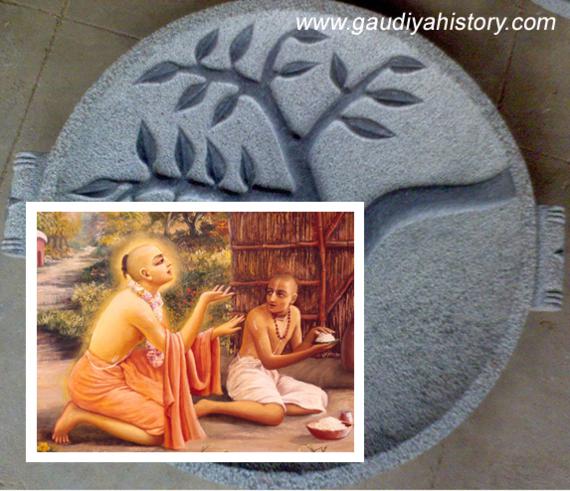
Raghunath Das Goswami’s ascetic vows that they were like lines drawn in stone. He spent 21 hours a day engaged in chanting Krishna’s names...He allowed no delicious foods to ever touch his tongue... Finally, he started going at night to gather the Prasad which the vendors outside the Temple threw away near the Simha-dvara after it started to go so bad that even the Tailangi cows would not eat it...“What is this all about? You are eating such nice things and not giving any to Me?” Saying this, the Lord snatched a morsel from Raghunath and ate it. As He was about to take another Svarupa Damodar caught Him by the hand and said, “It is not fit for You,” and took it away from Him. (3.6.322-3) (In the wallpaper: Shri Gauranga Mahaprabhu and Raghunatha Dasa Goswami, in the background a lines on the stone).
Shrila Raghunath Das Goswami has himself summarized these experiences in his verses called Chaitanya-stava-kalpa-vriksha (“The desire tree of Chaitanya Mahaprabhu’s glories”) which can be found in the collection called Stavavali.
maha-sampad-davad api patitam uddhritya kripaya
svarupe yah sviye kujanam api mam nyasya muditah
uro-guïja-haram priyam api ca govardhana-shilam
dadau me gaurango hridaya udayan mam madayati
By His mercy, Shri Gauranga took pleasure in delivering me even though I am a fallen soul, the lowest of men, from the blazing forest fire of great material opulence and entrusted me to His personal associate, Svarupa Damodar. He gave me the cherished gunja garland that He wore on His chest as well as His Govardhana Shila. And now He awakens within my heart and makes me mad after Him. (verse 11)
Raghunath Goes to Vrindavan
Raghunath remained under Svarupa Damodar’s tutelage as long as he stayed in Puri, thus gaining direct access to Mahaprabhu’s confidential service and association. In all, he remained there for sixteen years until the Lord and His chief confidant disappeared to the eyes of this world.
When this event took place, Raghunath felt that he could no longer live in their absence and decided to go to Vrindavan to commit suicide by jumping from Govardhana Hill. When he arrived in Vraja, he met Rupa and Sanatan Goswamis. They spoke to him for a long time and finally persuaded him not to put an end to his life. They adopted him as their third brother and kept him with them. Rupa and Sanatan were enriched by hearing the nectarean pastimes of Lord Shri Chaitanya Mahaprabhu from Raghunath.
Raghunath Das Goswami’s separation from Mahaprabhu and Radha-Krishna became so intense that he gave up eating solid food altogether, only drinking whey to sustain himself. He would pay a thousand prostrated obeisances, chant 100,000 Holy Names, serve Radha and Krishna mentally both day and night, recount the glorious pastimes of Lord Chaitanya Mahaprabhu and bathe three times a day without fail in Radha Kund. This was the exemplary standard of bhajana set by Raghunath in which he served their Lordships for more than 22 hours a day, sleeping only an hour and a half, if at all.
Raghunath’s renunciation may superficially be compared to that of the Buddha, but when examined more closely it will be observed that there are some unique characteristics in Raghunath’s asceticism. The external meaning of renunciation is detachment from sense gratification, but its true meaning is attachment to the supreme person. Raghunath’s strong attachment to the lotus feet of Radha and Krishna meant that he was completely and naturally detached from anything which was not connected to his worshipable Lord's.
Radha Kund
Shri Raghunath Das Goswami lived a long life. Shrinivas Acharya had the chance to receive Raghunath’s blessings before leaving Vrindavan to return to the East with the Goswamis’ books. Shrinivas was astounded by the powerful asceticism and deep absorption in love. Raghunath Das Goswami wrote three books: Stavavali, Shri Dana-charita (Dana-keli-chintamani) and Mukta-charita.
He lived in Radha Kund which was where he engaged in his most intense devotional practices. He was blessed there by Nityananda Prabhu’s widow, Jahnava Devi, when she visited Radha Kund.
When Mahaprabhu Himself visited the village of Arit and displayed His pastime of bathing in a rice field, by which He indicated the presence of Radha Kund and Shyama Kund. At that time the two tanks had not been excavated and finished with steps, etc. Raghunath himself thought it would be a good idea to have this work done, but had some reservations about getting involved in this kind of work. However, one day, a rich merchant who was on pilgrimage to Badari Narayan with the intention of donating a large sum of money to the Temple there. But Badari Narayan appeared to him in a dream and told him to fund Raghunath’s vision of a developed Radha Kund and Shyama Kund. The merchant came back to Vraja and found Raghunath in the village of Arit and recounted the story of the dream to him. Raghunath thus supervised the excavation of the ponds and the subsequent building of stone steps walkways.
Five trees stood on the banks of Shyama Kund which are said to be the five Pandavas. Raghunath had the intention of cutting down these trees so that Shyama Kund could be made perfectly rectangular. Before this could happen, however, Raghunath had a dream in which Yudhishthira appeared to him and told him that the five Pandavas were present in Radha Kund in the form of these trees. Raghunath immediately stopped the workers from cutting them down. This is why Shyama Kund was not built as a perfect rectangle.
Other Legends About Raghunath in Vraja
Another story is told about Raghunath Das Goswami. It is said that when he read Rupa Goswami’s play, Lalita Madhava, he was submerged in an ocean of separation. Though he was permanently in Radha’s association at Radha Kund, he was unable to tolerate even a momentary threat of separation, what to speak of intense feelings of Krishna’s absence. When he read the Lalita-madhava, which has separation from Krishna as its primary subject matter, this mood became so strong that it became doubtful that he would be able to survive. When Rupa saw Raghunath’s response to his play, he wrote another, short work named Dana-keli-kaumudi which is full of humor and amusing banter. He gave this book to Raghunath and took back his copy of Lalita-Madhava. When Raghunath read Dana-keli-kaumudi, he forgot his feelings of separation.
At first, when staying by Radha Kund Raghunath had no fixed shelter. He occasionally stayed with Gopal Bhatta Goswami, whose cottage was situated on the banks of the Manasa-Ganga in Govardhana. One day he took bath in the Manasa-Ganga and then went to sit under a tree surrounded by unkept thickets and began to worship the Lord in a devotional trance. While he was meditating, a tiger came there to drink water. Sanatan Goswami was also present there at the time and observed Raghunath as he remained unmoved even though exposed to such danger. He instructed Raghunath to build a cottage in which to live and engage in his devotional activities.
Shrila Raghunath Das Goswami had special affection for a certain Vrajavasi whose name was Das. Raghunath’s daily nourishment consisted of only a leaf bowl of whey. This Vrajavasi was distressed to learn that Raghunath ate so little, thinking that it was impossible for him to keep alive on such a small amount. One day when in the village known as Sakhisthali, he was overjoyed to see a silk cotton tree with huge leaves. He had a bigger sized bowl made with these leaves in which he put whey for Raghunath and then brought it to him. Raghunath was quite astonished to see such a large leaf-bowl and asked him where he got it. When he heard the name of Sakhisthali, he immediately threw down the bowl and the whey. Sakhisthali is the home of Chandravali, Radharani’s primary rival for Krishna’s love. Chandravali’s sakhis like Shaivya and Padma are constantly looking for ways to take Krishna away from Radha’s bower and bring him to that of their girlfriend. Just as Radharani is distressed by these actions, so are her girlfriends. Raghunath was a member of Radharani’s entourage and so it was his role to constantly think of how to bring happiness to her and her girlfriends. As soon as he heard the name of Sakhisthali mentioned, he was transported by anger. This mood is the ultimate stage of love which envious people who are burdened by material lust could never understand. In the Bhakti-ratnakara, it is written,
After calming down, Raghunath said to Das, “That is Chandravali’s place. You shouldn’t ever go there.” Das Vrajavasi calmed down and recognized that these were the symptoms of spiritual perfection in what was apparently a spiritual aspirant. All these Devotees are eternally perfected souls. Anyone who doubts it must be considered fallen. (Bhakti-ratnakara 5.572-4)
There is one other extraordinary legend about Raghunath Das Goswami recounted in the Bhakti-ratnakara. One day he was suffering from indigestion. Vitthalanatha came with two doctors from Vallabhapura to cure Raghunath Das. After examining him, the doctors said that the indigestion had been caused by eating rice and milk. Vitthalanatha was astonished to hear this diagnosis and said, “This is impossible. This man never eats anything but whey.” Raghunath then spoke up, saying that he had indeed eaten milk and rice in the course of his meditation on the pastimes of Radha and Krishna.
Shri Raghunath Das Goswami left his body on the banks of Radha Kund where his samadhi tomb stands. This took place on th Shukla Dvadashi tithi of the month of Ashwina, in the year 1586.
[Excerpted from “Shri Chaitanya: His Life & Associates” by Shrila Bhakti Ballabh Tirtha Maharaj]
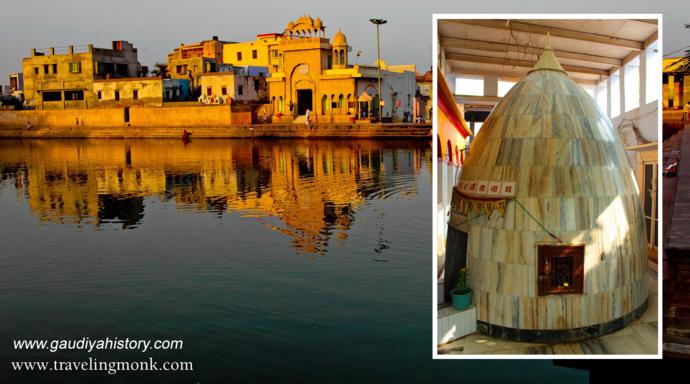
Shri Raghunath Das Goswami left his body on the banks of Radha Kund where his samadhi tomb stands. This took place on th Shukla Dvadashi tithi of the month of Ashwina, in the year 1586. (In the wallpaper: Samadhi of Shrila Raghunatha Dasa Goswami, in the background Shri Radha Kund).
